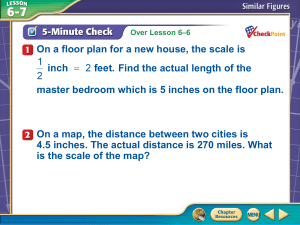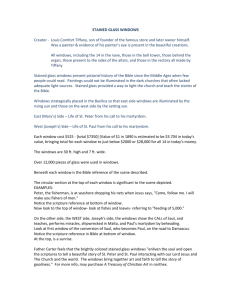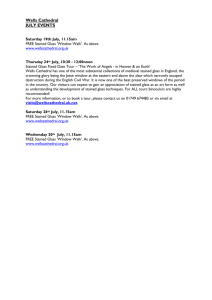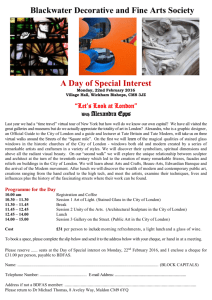Grade 7 Geometry Performance Tasks Take the Ancient Greek
advertisement
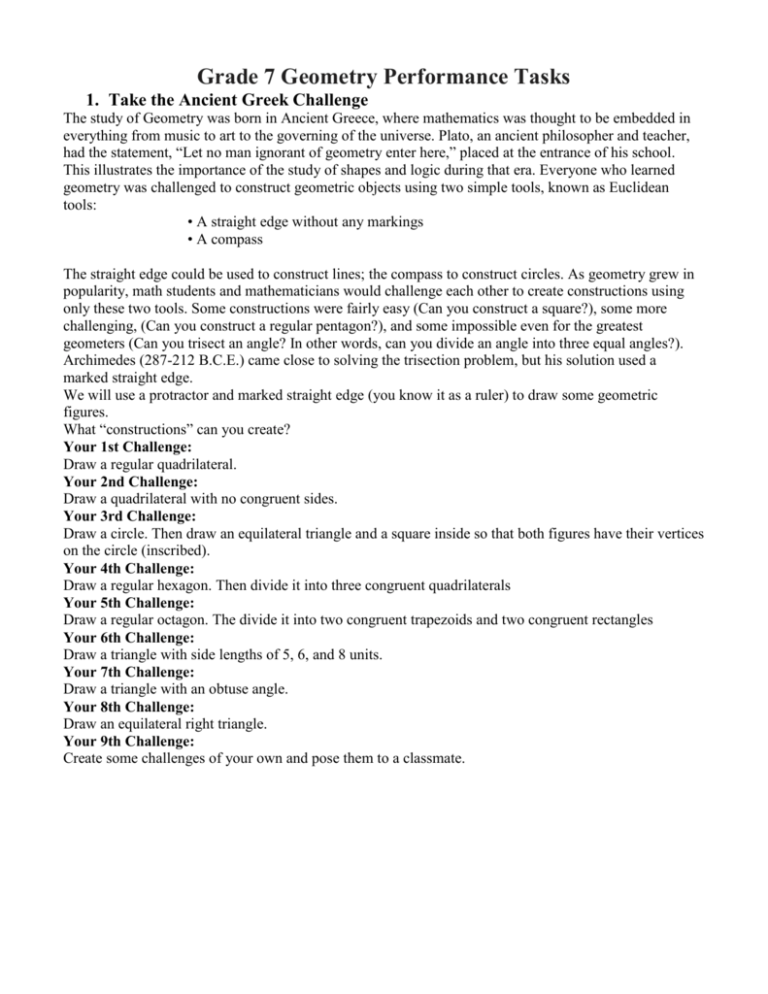
Grade 7 Geometry Performance Tasks 1. Take the Ancient Greek Challenge The study of Geometry was born in Ancient Greece, where mathematics was thought to be embedded in everything from music to art to the governing of the universe. Plato, an ancient philosopher and teacher, had the statement, “Let no man ignorant of geometry enter here,” placed at the entrance of his school. This illustrates the importance of the study of shapes and logic during that era. Everyone who learned geometry was challenged to construct geometric objects using two simple tools, known as Euclidean tools: • A straight edge without any markings • A compass The straight edge could be used to construct lines; the compass to construct circles. As geometry grew in popularity, math students and mathematicians would challenge each other to create constructions using only these two tools. Some constructions were fairly easy (Can you construct a square?), some more challenging, (Can you construct a regular pentagon?), and some impossible even for the greatest geometers (Can you trisect an angle? In other words, can you divide an angle into three equal angles?). Archimedes (287-212 B.C.E.) came close to solving the trisection problem, but his solution used a marked straight edge. We will use a protractor and marked straight edge (you know it as a ruler) to draw some geometric figures. What “constructions” can you create? Your 1st Challenge: Draw a regular quadrilateral. Your 2nd Challenge: Draw a quadrilateral with no congruent sides. Your 3rd Challenge: Draw a circle. Then draw an equilateral triangle and a square inside so that both figures have their vertices on the circle (inscribed). Your 4th Challenge: Draw a regular hexagon. Then divide it into three congruent quadrilaterals Your 5th Challenge: Draw a regular octagon. The divide it into two congruent trapezoids and two congruent rectangles Your 6th Challenge: Draw a triangle with side lengths of 5, 6, and 8 units. Your 7th Challenge: Draw a triangle with an obtuse angle. Your 8th Challenge: Draw an equilateral right triangle. Your 9th Challenge: Create some challenges of your own and pose them to a classmate. 2. Boxing Bracelets You are the owner of a prestigious jewelry store that sells popular bracelets. They are packaged in boxes that measure 8.3 centimeters by 11 centimeters by 2 ½ centimeters. Part I. a. Sketch a drawing of the box and label its dimensions. b. Estimate the volume of the bracelet box. c. Find the volume of the bracelet box. Be sure to show all of your work. Part II. Suppose the company that makes your boxes is out of the ones that you usually purchase. They have offered to send you another size box for the same cost. The three different boxes that you may choose from have two of the dimensions the same as your regular box, but increase one of the dimensions by exactly 1 centimeter. d. Make a prediction of which box you would order if you wanted the largest possible increase in volume. Explain with details how you could be certain of which dimension you should increase. Test your prediction. Was your prediction correct? Why or why not? e. Make a sketch of the new box and label its dimensions. Find the volume of the new box. Be sure to show all of your work. f. What is the difference of the volume of the original box and the volume of the new box? g. What is the ratio of the difference from part (f) and the original volume part (e)? h. What is the percent that is equivalent to the ratio found in part (g)? (This is known as the percent of increase.) Part III. Some of your customers frequently like to have their bracelets gift wrapped. To determine the price for wrapping the new boxes, you wish to compare the surface area of the original box to the surface area of the box with the largest volume. (See part d.) i. Estimate the surface area of the two boxes. j. Find the actual surface area for each box. Were your estimates close to your actual results? Why or why not? k. What is the difference between the two surface areas? l. What is the ratio of the difference from part (j) and the surface area of the original box? m. What is the percent that is equivalent to the ratio found in part (l) (percent of increase)? n. If you charge $2.00 to gift wrap the original box, how much should you charge to gift wrap the new box? Justify your answer. 3. Stained Glass Designs Windows to the World is a locally owned company specializing in stained glass windows. You have just been hired to create stained glass designs for circular windows. As part of your agreement, you need to submit a design. You may include both regular and irregular shapes in your original stained glass window design. Windows to the World has certain requirements for their circular windows: • All designs must fit inside windows with an area ranging from 200 in2 to 400 in2. • All designs must include at least three different sets of congruent figures. • Each design must include a supplies/materials list and cost of materials. Windows to the World increases the selling price for their windows for resale. The selling cost for each window is the cost of the materials multiplied by 1.5. • Create a formula to calculate the selling price, and then use the formula to find the selling price for your design. Windows to the World pays for the supplies you used to create the window design. For each design, your commission is ¾ the cost of the materials. • Create a formula for finding the commission for each design. You need to submit an invoice with the formula you used to calculate your commission as well the total cost including the cost of the materials and the commission. IMPORTANT: Sheets of glass are only sold in square foot sections (12 inches x 12 inches). Prices range from $6.12 to $11.46, depending on the color. A price list is included for your use. Stained Glass Supplies Sheets of Glass are sold by the square foot. Color Cost per square foot Clear/White $6.12 Blue $6.93 Pink $10.26 Black $7.14 Gray $6.12 Green $6.93 Orange $11.01 Purple $6.12 Red $10.74 Yellow $11.46 White $6.12

